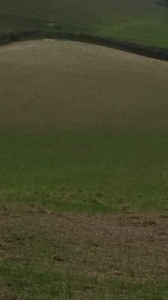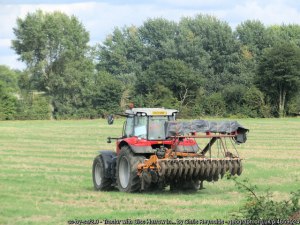Growing crops is a race against time to beat the autumn equinox at the end of September. Farmers have been working round the clock through August to get the harvest in: if there are few windows of dry weather a farmer may literally work around the crop as a wet crop is a lost crop.
 Bucolic scenes of rustics enjoying a well-earned rest after the harvest home are visions of a world which vanished decades ago (if it ever existed!). Even before the harvest was finished in September the ground of those fields whose productivity was finished for this season was being prepared for their 2016 crops.
Bucolic scenes of rustics enjoying a well-earned rest after the harvest home are visions of a world which vanished decades ago (if it ever existed!). Even before the harvest was finished in September the ground of those fields whose productivity was finished for this season was being prepared for their 2016 crops.
Elwell is a field nestled between the Hill and the water meadows around the River. It’s soil has become deep and clayey through the gradual erosion of the Hill over dozens of millennia. In the 2015 season it was a grass ‘ley’ – a field of grass which has been planted with a special mix of grasses and clover. Planting a grass ley is a way for a farmer to practice rotation to preserve the fertility of the soil whilst at the same time using it productively (in this case grass for the dairy and beef herd).
In September the ley was ‘sprayed off’ with glyphosate (which gardeners call Roundup). This means that when the new crop is planted there are no persistent weeds whose roots will simply resprout after the field has been ploughed and planted. Roundup is a chemical which is indispensable to modern farming. Maybe this is why it has a habit of being in the news. Here is a link to a recent article about its possible role in causing cancer.
After about 5 days the ley, together with the weeds that have grown the previous year, has died back. The next step is to add rotted farmyard manure – the straw bedding accumulated over the previous winter when cows were being kept in the barns. This post explains a bit of the hows and whys of this.
The third stage is to plough the field.
As the soil in Elwell is so clayey it needed extra cultivation because it sticks together in large lumps. So when the soil had dried out a bit the whole field was cultivated with a disk harrow. Each disc is a bit like a pizza slicer – it cuts as it rotates.
Well, now the work is about halfway done. Someone still needs to drive a tractor back and forth across the whole field FOUR more times before they can pause a while. Even then they cannot rest: the field will have to be monitored for pests including slugs.
Is elwell the field that the footpath crosses? Sounds like a lot of hard work. Well done farmers!
LikeLike
Yes. The woods along the righthand side are there because there’s a line of springs and ponds – hence the name.
LikeLiked by 1 person